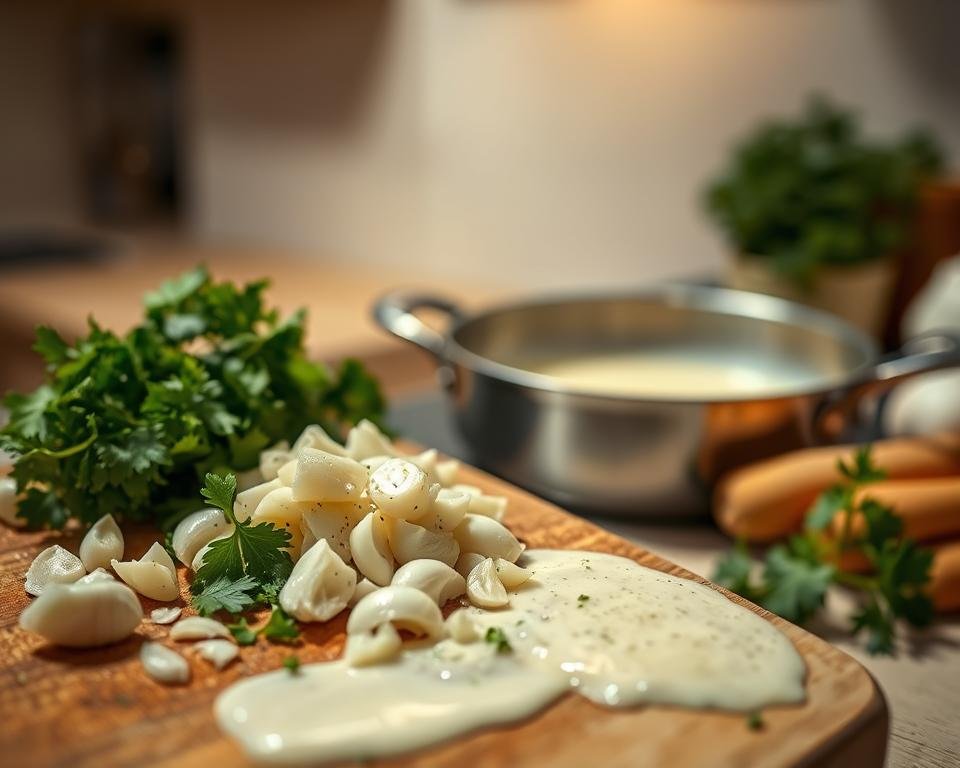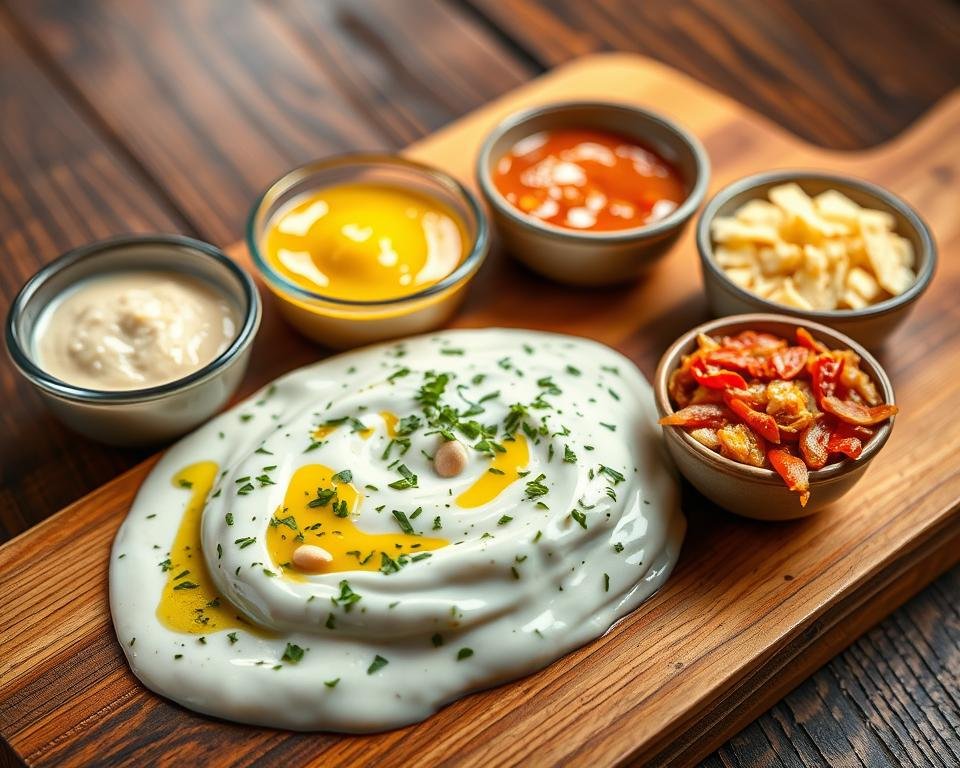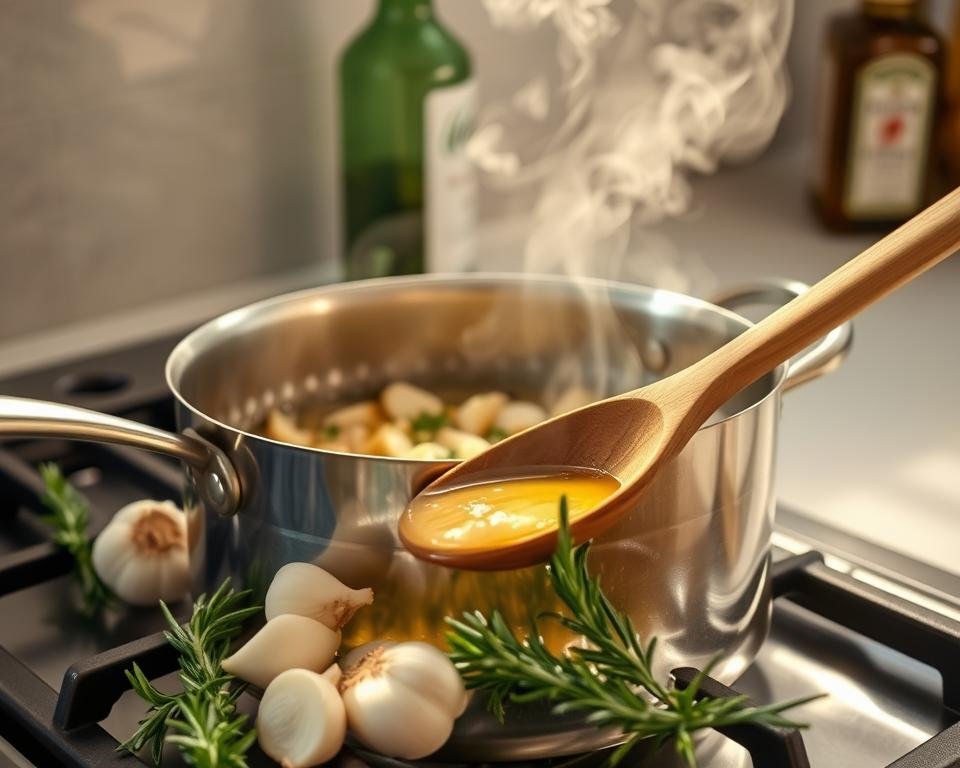There’s something magical about a sauce that transforms a simple dish into a restaurant-worthy experience. When we first tasted the garlic herb sauce at Olive Garden, its light yet bold flavors stood out. Unlike heavier options, this blend brings freshness to every bite.
After testing the recipe with an Italian exchange student, we confirmed its authenticity. The homemade version delivers the same rich taste—maybe even better. Ready in just 20 minutes, it pairs perfectly with any pasta.
Whether you prefer gluten-free or classic fettuccine, this versatile sauce adapts effortlessly. Now, let’s bring that Italian restaurant magic to your kitchen.
Key Takeaways
- Recreates Olive Garden’s nationwide garlic herb sauce at home
- Approved by an Italian taste-tester for authenticity
- Lighter flavor compared to traditional Alfredo or meat sauces
- Ready in 20 minutes—matches pasta cooking time
- Works with various pasta types and dietary needs
Why You’ll Love This Garlic Herb Sauce
Light yet bold, this recipe redefines pasta night. Unlike traditional cream-based sauces, it lets fresh ingredients shine. A splash of white wine or chicken broth builds depth without heaviness.
A Lighter, Fresher Alternative
At just 178 calories per serving, this version cuts half the fat of Alfredo. The table below highlights the difference:
| Sauce Type | Calories | Prep Time |
|---|---|---|
| Traditional Alfredo | 320 | 25 minutes |
| Garlic Herb Sauce | 178 | 20 minutes |
Our Italian taste tester praised the homemade texture. Freshly minced garlic adds a brighter kick than pre-packaged versions.
Quick and Effortless Prep
One pan and 20 minutes are all you’ll need. The sauce finishes as pasta cooks—no wasted time. For dietary tweaks, swap wine with extra broth.
Pair it with gluten-free noodles or drizzle over breadsticks. Adaptable for dietary needs, it’s a weeknight hero.
Ingredients for the Best Olive Garden Garlic Herb Sauce
Creating an authentic Italian sauce starts with fresh, high-quality components. We tested multiple variations to nail the balance of richness and brightness. Below, find everything required to replicate that signature taste.
Essential Ingredients for Bold Flavor
The foundation relies on a few key items. Butter and garlic cloves form the base, while a Zesty Italian Seasoning packet adds depth. Cornstarch and flour work together for a silky texture.
- Butter: 4 tbsp (Kerrygold recommended for richness)
- Garlic: 10 cloves, minced or pressed
- White wine: ½ cup (Sauvignon Blanc or Chardonnay)
- Thickeners: 1 tbsp cornstarch + 1 tbsp flour
- Seasoning: 1 packet Zesty Italian Dressing mix
Optional Add-Ins for Extra Depth
Customize with proteins or vegetables. Grilled chicken or mushrooms complement the sauce beautifully. For a non-alcoholic version, swap wine with chicken broth.
| Ingredient | Alternative | Effect |
|---|---|---|
| White wine | Chicken broth | Milder, alcohol-free |
| Dried rosemary | Fresh thyme | Brighter herbal notes |
| Parmesan | Pecorino Romano | Sharper, saltier finish |
For a creamier texture, stir in organic half-and-half. Fresh basil or parsley adds a vibrant finish. Experiment to make it your own!
Step-by-Step Recipe Instructions
Mastering this recipe means unlocking restaurant-quality flavors in minutes. We’ll guide you through each phase, from melting butter to garnishing with fresh herbs. Perfect consistency and timing are key.
Preparing Your Pasta and Sauce Base
Start by heating a skillet to medium-high (375°F). Melt 4 tbsp butter until frothy—this takes about 1 minute. Add 10 minced garlic cloves, stirring for 30 seconds to release aroma.

Cook pasta separately, aligning its 10-minute boil with the sauce prep. Salt the water generously for flavor infusion.
Combining Ingredients for Perfect Consistency
Whisk in 1 tbsp flour to create a roux, then pour ½ cup white wine slowly. A cornstarch slurry (1 tbsp cornstarch + 2 tbsp water) ensures lump-free thickening. Simmer for 3–4 minutes, stirring constantly.
“The roux should coat the back of a spoon—that’s your cue to add liquids.”
| Step | Time | Visual Cue |
|---|---|---|
| Butter/Garlic Sauté | 1–2 minutes | Golden edges |
| Roux Simmer | 3–4 minutes | Thickened texture |
| Final Simmer | 5 minutes | Velvety sheen |
Finishing Touches for Maximum Flavor
Off heat, stir in 1 tsp lemon juice and 1 tbsp chopped parsley. Reserve extra parsley for garnish. For depth, add a pinch of italian seasoning and black pepper.
Toss with pasta immediately. The sauce thickens slightly upon standing—serve warm for ideal texture.
Recipe Variations to Customize Your Sauce
Transform your pasta nights with endless customization options for this versatile sauce. Whether you crave extra protein or a veggie-packed twist, these adaptations keep meals exciting.

Adding Protein for a Heartier Dish
Incorporate protein to turn this sauce into a complete meal. Grilled chicken or air-fried shrimp blend seamlessly with the garlicky base. Salmon adds richness, while turkey meatballs offer a leaner option.
| Protein | Prep Tip | Pairing Note |
|---|---|---|
| Grilled Chicken | Marinate in lemon juice | Balances herb flavors |
| Shrimp | Sauté with paprika | Adds subtle smokiness |
| Salmon | Pan-sear skin-side down | Complements creamy texture |
Enhancing with Cheese and Vegetables
For a vegetarian dish, roast bell peppers or zucchini. Stir in Parmesan cheese for umami depth, or try Romano for a sharper kick. Spinach wilts beautifully into the warm sauce.
- Creamier version: Swap mayo for mascarpone
- Spicy twist: Add red pepper flakes
- Gluten-free: Use cornstarch instead of flour
- Dairy-free: Coconut cream mimics richness
Experiment with these tweaks to match dietary needs or flavor cravings. Each addition brings a new dimension to the recipe.
Tips for the Perfect Garlic Herb Sauce Every Time
Crafting a flawless sauce requires attention to detail. These professional techniques ensure consistent results, whether you’re cooking for family or guests. Let’s dive into the secrets behind texture and flavor mastery.

Adjusting Thickness and Flavor Balance
Control your sauce’s consistency with these simple tricks. For a thinner texture, add warm broth one tablespoon at a time. Thicken it with a cornstarch slurry (1:2 ratio) if needed.
Flavor balance is key. A pinch of salt enhances herbs without overpowering. Layer seasoning by adding half during cooking and half at the end. Acidic elements like lemon juice cut through richness—start with ½ tsp and adjust.
- Garlic prep: Mincing releases milder flavors than pressing
- Herb test: Rub dried herbs between fingers—if no aroma, replace them
- Wine choice: Dry whites like Sauvignon Blanc add bright acidity
Using Fresh vs. Prepared Ingredients
Fresh garlic cloves deliver superior depth compared to pre-minced versions. For herbs, fresh parsley and rosemary shine, while dried italian seasoning works in a pinch.
Quality matters with dairy too. Freshly grated parmesan melts smoother than pre-shredded varieties. As this recipe demonstrates, proper ingredient prep makes all the difference.
“A golden roux indicates nutty flavor development—stop cooking when it reaches pale amber.”
For emergency fixes, remember these solutions:
| Issue | Solution |
|---|---|
| Too thick | Whisk in warm liquid gradually |
| Too thin | Simmer longer or add slurry |
| Separated | Blend briefly or whisk vigorously |
With these techniques, your sauce will turn out perfectly every time. Experiment to find your ideal balance of flavors and textures.
Serving Suggestions for Your Garlic Herb Sauce
From breakfast to appetizers, this sauce shines in every dish. Its balanced flavors complement everything from hearty pastas to light salads. Below, explore classic and unexpected ways to enjoy it.
Classic Pasta Pairings
Long, flat noodles like fettuccine or linguine catch the sauce beautifully. For texture, try al dente spaghetti or rigatoni. Toss with grilled chicken or sautéed mushrooms for added depth.
Top with freshly grated Parmesan cheese and a sprinkle of herbs. For a lighter twist, mix with zucchini noodles or gluten-free pasta.
Creative Uses Beyond Pasta
Transform the recipe into a dip for warm breadsticks or crusty baguettes. Brush it over roasted vegetables like asparagus or Brussels sprouts for extra flavor.
- Breakfast: Drizzle over poached eggs or avocado toast
- Appetizer: Serve as a fondue with artichokes or pretzels
- Salad: Thin with lemon juice for a vibrant dressing
- Pizza: Swap tomato sauce for a garlic-herb base
“Marinate proteins in the sauce before grilling—it tenderizes and infuses flavor.”
For a quick appetizer, layer it on crostini with sun-dried tomatoes. The possibilities are endless!
Storing and Reheating Your Leftover Sauce
Proper storage keeps your homemade sauce tasting fresh for days. Follow these guidelines to maintain flavor and texture while ensuring food safety. Glass containers work best for preserving quality.
Keeping It Fresh in the Fridge
Cool the sauce completely before refrigerating—about 30 minutes at room temperature. Transfer to an airtight glass container for optimal freshness. Plastic can absorb odors over time.
- Storage duration: Up to 5 days in refrigerator
- Container size: Leave ½ inch headspace for expansion
- Prevention tip: Press plastic wrap directly on surface to prevent skin formation
For dairy-based versions, stir in 1 tsp lemon juice before storing. This helps prevent separation when reheating.
Freezing for Long-Term Storage
Portion the sauce into single-serving sizes for convenient use. Ice cube trays work well for small amounts, while freezer bags suit larger quantities.
| Storage Method | Duration | Thawing Time |
|---|---|---|
| Freezer bags (flat) | 3 months | Overnight in fridge |
| Glass jars | 2 months | Cold water bath |
| Silicone molds | 1 month | 10 minutes at room temp |
Label containers with the date and ingredients used. Thaw frozen portions gradually in the refrigerator for best results.
Reheating Without Compromising Quality
Warm your sauce gently over low-medium heat, stirring frequently. Add a splash of broth or milk if the texture thickens too much.
“Reheat only what you’ll use—repeated warming degrades flavor and texture.”
For microwave reheating:
- Use 50% power setting
- Stir every 30 seconds
- Cover with damp paper towel
Revive flavors with fresh herbs or a pinch of salt and pepper before serving. Avoid boiling to prevent dairy separation.
Conclusion
Bringing restaurant flavors home has never been easier with this versatile recipe. Our version balances freshness and richness, just like the original—approved by an Italian taste-tester. A hint of Italian seasoning and bright herbs makes it stand out.
Experiment with proteins or veggies to elevate any dish. Share your creations using #HerbSauceMagic. For more copycat recipes, join our newsletter.
Love this garlic herb twist? Rate the recipe or tag us. Your feedback helps us craft more kitchen wins!
